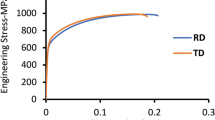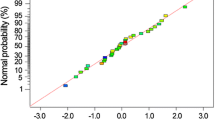Abstract
The current paper presents an alternative method for failure strength prediction of spot-welded joints in aluminum, based on nonlinear regression analysis, namely, the kernel ridge regression method. Welding parameters such as electrode force, welding current, and welding time are studied in the experimental investigation to measure their effects on the nugget size and failure strength of the resistance spot welds. Coupons are manufactured and tensile tested and the results show that the welding current and time have the largest effect on the nugget size and the failure strength. The results of this study are compared to those of the least squares method and they indicate that the truncated-regularized kernel ridge regression algorithm significantly improves the coefficient of determination and reduces the mean squared error.
Similar content being viewed by others
References
(1997) Recommended practices for test methods and evaluation the resistance spot welding behavior of automotive sheet steels. Standard, ANSI/AWS/SAE
Afshari D (2013) Mechanical properties of resistance spot welds in lightweight applications
Afshari D, Sedighi M, Barsoum Z, Peng RL (2012) An approach in prediction of failure in resistance spot welded aluminum 6061-t6 under quasi-static tensile test. Proc Inst Mech Eng B J Eng Manuf 226(6):1026–1032
Afshari D, Sedighi M, Karimi MR, Barsoum Z (2013) On residual stresses in resistance spot-welded aluminum alloy 6061-t6: experimental and numerical analysis. J Mater Eng Perform 22(12):3612–3619
Afshari D, Sedighi M, Karimi MR, Barsoum Z, Isikveren A (2016) Prediction of residual stresses in resistance spot weld. Aircr Eng Aerosp Technol 88(4):492–497
Bertin L (2014) Tensile strength of automotive aluminum joints using resistance spot welding, self-piercing riveting and adhesive hybrid joining. Electronic Theses and Dissertations. Paper 5234.
ASME Boiler, Pressure Vessel Committee et al (2007) Qualification standard for welding and brazing procedures, welders, brazers, and welding and brazing operators. American Society of Mechanical Engineers
Chao YJ (2003) Ultimate strength and failure mechanism of resistance spot weld subjected to tensile, shear, or combined tensile/shear loads. J Eng Mater Technol 125:125–132
De A, Gupta OP, Dorn L (1996) An experimental study of resistance spot welding in 1 mm thick sheet of low carbon steel. Proc Inst Mech Eng B J Eng Manuf 210(4):341–347
Exterkate P (2011) Modelling issues in kernel ridge regression. Technical report, Tinbergen Institute Discussion Paper Series
Fox J (2008) Applied regression analysis and generalized linear models. Sage, Newbury Park
Goh ATC, Goh SH (2007) Support vector machines: their use in geotechnical engineering as illustrated using seismic liquefaction data. Comput Geotech 34:410–421
Gunn SR (1998) Support vector machine for classification and regression. Technical report, University of Southampton
Hassanifard S, Zehsaz M (2010) The effect of residual stresses on the fatigue life of 5083-o aluminum alloy spot welded joints. Fatigue 2(1):1077–1085
Lewis JM, Lakshmivarahan S, Dhall S (2006) Dynamic data assimilation: a least squares approach. Cambridge University Press, Cambridge
Maalouf M, Homouz D (2014) Kernel ridge regression using truncated newton method. Knowl-Based Syst 71:339–344
Maalouf M, Khoury N, Laguros JG, Kumin H (2012) Support vector regression to predict the performance of stabilized aggregate bases subject to wet-dry cycles. Int J Numer Anal Methods Geomech 36(6):675–696
Maalouf M, Khoury N, Trafalis TB (2008) Support vector regression to predict asphalt mix performance. Int J Numer Anal Methods Geomech 32:1989–1996
Maalouf M, Trafalis TB, Adrianto I (2011) Kernel logistic regression using truncated newton method. Comput Manag Sci 8(4):415–428
Manladan S, Yusof F, Ramesh S, Fadzil M (2016) A review on resistance spot welding of magnesium alloys. Int J Adv Manuf Technol 86(5):1805–1825
Manladan S, Yusof F, Ramesh S, Fadzil M, Luo Z, Ao S (2016) A review on resistance spot welding of aluminum alloys. Int J Adv Manuf Technol:1–30
Marya M, Wang K, Hector LG, Gayden X (2006) Tensile-shear forces and fracture modes in single and multiple weld specimens in dual-phase steels. J Manuf Sci Eng 128(1):287– 298
Montgomery DC, Peck EA, Vining GG (2012) Introduction to linear regression analysis, 5 edn. Wiley, New York
Pereira AM, Ferreira JM, Loureiro AJ, Costa DM, Bartolo PJ (2010) Effect of process parameters on the strength of resistance spot welds in 6082-t6 aluminum alloy. Mater Des 31(5):2454–2463
Phillips-Wren G (ed) (2010) Advances in intelligent decision technologies: proceedings of the second KES international symposium IDT 2010 (Smart Innovation, Systems and Technologies). Spri
Pouranvari M, Asgari HR, Mosavizadch SM, Marashi PH, Goodarzi M (2007) Effect of weld nugget size on overload failure mode of resistance spot welds. Sci Technol Weld Join 12(3):217–225
Priddy KL, Keller PE (2005) Artificial neural networks: an introduction, illustrated edition. SPIE, Bellingham
Saunders C, Gammerman A, Vovk V (1998) Ridge regression learning algorithm in dual variables. In: Proceedings of the 15th international conference on machine learning. Morgan Kaufmann, pp 515–521
Shawe-Taylor J, Cristianini N (2004) Kernel methods for pattern analysis. Cambridge University Press, Cambridge
Smola AJ, Scholkopf B (2004) A tutorial on support vector regression. Stat Comput 14:199–222
Sun X, Stephens EV, Khaleel MA (2008) Effects of fusion zone size and failure mode on peak load and energy absorption of advanced high strength steel spot welds under lap shear loading conditions. Eng Fail Anal 15(4):356–367
Sagüés Tanco J, Nielsen CV, Chergui A, Zhang W, Bay N (2015) Weld nugget formation in resistance spot welding of new lightweight sandwich material. Int J Adv Manuf Technol 80(5):1137–1147
Vapnik V (1995) The nature of statistical learning. Springer, New York
Author information
Authors and Affiliations
Corresponding author
Rights and permissions
About this article
Cite this article
Maalouf, M., Barsoum, Z. Failure strength prediction of aluminum spot-welded joints using kernel ridge regression. Int J Adv Manuf Technol 91, 3717–3725 (2017). https://doi.org/10.1007/s00170-017-0070-2
Received:
Accepted:
Published:
Issue Date:
DOI: https://doi.org/10.1007/s00170-017-0070-2




